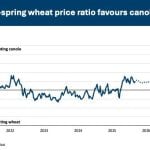Chinese researchers are moving forward with a transgenic pig, which is similar to an “Enviro-pig” developed at the University of Guelph.
In a paper published May 22, in a biochemistry and chemical biology journal, scientists from South China Agricultural University and China Agricultural University, wrote about “novel” transgenic hogs that grow faster and have less impact on the environment.
Pigs emit a high percentage of nitrogen and phosphorus because they cannot efficiently digest the nutrients in their feed. The nutrients from the manure can wind up in lakes and rivers, polluting water bodies with high levels of phosphorus.
Read Also

Beef cattle more prone to trace mineral deficiencies
The trace mineral status of our cows and calves is a significant challenge for western Canadian producers and veterinarians.
“In pig production, only one-third of feed N and P is metabolically utilized from cereal and soybean-based diets,” the scientists said.
The Chinese researchers introduced foreign genes to change enzymes in the pigs. They altered the salivary glands to produce more phytase, so the animals could digest more of the nutrients in their feed.
“We established stable transgenic pig lines that co-expressed NSP (non-starch polysaccharides) degrading enzymes and phytase in saliva,” the paper noted.
Feeding trials showed that the amount of nitrogen and phosphorus in the transgenic pigs’ manure was reduced by 23 to 45 percent. And the growth rate of the animals improved by 23 to 24 percent.
“This genetic strategy offers a very valuable biological solution for inefficient feed digestion and environmental emissions due to the global expansion of the livestock industry,” the scientists wrote in the paper.
The research seems to build upon work done at the University of Guelph in the late 1990s and 2000s. U of Guelph researchers used foreign genes from mice and bacteria so transgenic pigs could produce enzymes that break down phosphorus and therefore digest more of the nutrient in their feed.
The research and development of an “Enviro-pig” stalled around 2010 to 2012, because the hog industry feared a public backlash against a genetically modified pig.
Mingzhe Fan was one of the U of Guelph scientists who worked on the original project. He is now collaborating with Chinese researchers on the new and improved transgenic pig.
The Western Producer contacted Fan for this story, but he re-directed questions to Zhenfang Wu, the project leader.
Wu, on the Phys.org website, said the genetic modification had no negative impacts on the pigs. Their behaviour and reproduction was unchanged.
But it’s not clear that Chinese consumers are ready for a transgenic pig, Wu added.
“The use of genetically modified pigs and other animals in food production, both in China and globally, is restricted by current policy. However, our findings indicate that these pigs are promising resources for improving feed efficiency and reducing the carbon footprint of the pork industry.”
China, which has about half of the pigs in the world, may be tempted to adopt genetic technology so the country is self sufficient in pork production.
Interestingly a scientist from Europe, where genetically modified food is about as popular as leprosy, praised the Chinese efforts to develop a transgenic pig.
Bjorn Petersen, of the Friedrich Loeffler Institut in Germany, said cutting the amount of nitrogen and phosphorus in pig manure is an excellent way to reduce water pollution.
“Besides excreting fewer polluting nutrients, the transgenic pigs also grew better and fattened up more quickly. In fact, on average, they put on 24 percent more weight every day than their non-modified counterparts…. This is an advantage that ‘Enviropig’ did not have…. The pigs developed by Zhang et al. might create a win-win situation for both farmers and environment.”















